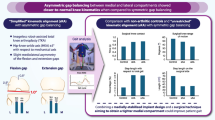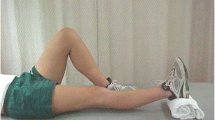Abstract
Surgical technique is an important factor affecting recovery of hip function after total hip arthroplasty (THA). We therefore asked whether short-term recovery of hip strength and motion would differ between the anterior and anterolateral THA approaches. We presumed that although both approaches would improve hip function by 16 weeks postsurgery when compared with presurgery, a slower recovery would be demonstrated by the anterolateral group at 6 weeks when compared with the anterior group as a result of division and reattachment of the abductor muscles. We observed hip kinematics and kinetics during walking and isometric hip abductor strength for the involved limb. Hip abductor strength of all patients was lower than controls at all three testing times. Compared with presurgery, all patients demonstrated improved abductor strength at 16 weeks postsurgery. At 6 weeks, the patients with an anterior approach had improved late stance peak abductor moment postsurgery and reached the level of controls, but those with an anterolateral approach did not. Although the anterior approach was associated with improved gait velocity and peak flexor moments at 6 weeks compared to before surgery, we observed no differences between the two approaches for most of the isometric strength and dynamic gait measures at 6 or 16 weeks. Neither approach provided faster recovery.

Similar content being viewed by others
References
Baker AS, Bitounis VC. Abductor function after total hip replacement. An electromyographic and clinical review. J Bone Joint Surg Br. 1989;71:47–50.
DeWal H, Su E, DiCesare PE. Instability following total hip arthroplasty. Am J Orthop. 2003;32:377–382.
Downing ND, Clark DI, Hutchinson JW, Colclough K, Howard PW. Hip abductor strength following total hip arthroplasty: a prospective comparison of the posterior and lateral approach in 100 patients. Acta Orthop Scand. 2001;72:215–220.
Foucher KC, Hurwitz DE, Wimmer MA. Preoperative gait adaptations persist one year after surgery in clinically well-functioning total hip replacement patients. J Biomech. 2007;40:3432–3437.
Hahn ME, Chou LS. Age-related reduction in sagittal plane center of mass motion during obstacle crossing. J Biomech. 2004;37:837–844.
Hardinge K. The direct lateral approach. J Bone Joint Surg Br. 1982;64:17–19.
Harris WH. Traumatic arthritis of the hip after dislocation and acetabular fractures: treatment by mold arthroplasty. An end-result study using a new method of result evaluation. J Bone Joint Surg Am. 1969;51:737–755.
Hurwitz DE, Hulet CH, Andriacchi TP, Rosenberg AG, Galante JO. Gait compensations in patients with osteoarthritis of the hip and their relationship to pain and passive hip motion. J Orthop Res. 1997;15:629–635.
Irving JF. Direct two-incision total hip replacement without fluoroscopy. Orthop Clin North Am. 2004;35:173–181.
Kennon RE, Keggi JM, Wetmore RS, Zatorski LE, Huo MH, Keggi KJ. Total hip arthroplasty through a minimally invasive anterior surgical approach. J Bone Joint Surg Am. 2003;85(Suppl 4):39–48.
Keppel G, Wickens T. Design and Analysis: A Researcher’s Handbook. Upper Saddle River, NJ: Pearson Prentice Hall; 2004.
Keppel G, Zedeck S. Data Analysis for Research Designs: Analysis of Variance and Multiple Regression/Correlation Approaches. New York, NY: WH Freeman and Company; 1989.
Martini F, Timmons M, Tallitsch R. Human Anatomy. Upper Saddle River, NJ: Pearson Education Inc; 2003.
Masonis JL, Bourne RB. Surgical approach, abductor function, and total hip arthroplasty dislocation. Clin Orthop Relat Res. 2002;405:46–53.
Matta JM, Shahrdar C, Ferguson T. Single-incision anterior approach for total hip arthroplasty on an orthopaedic table. Clin Orthop Relat Res. 2005;441:115–124.
McCrory JL, White SC, Lifeso RM. Vertical ground reaction force: objective measures of gait following hip arthroplasty. Gait Posture. 2001;14:104–109.
Mont MA, Seyler TM, Ragland PS, Starr R, Erhart J, Bhave A. Gait analysis of patients with resurfacing hip arthroplasty compared with hip osteoarthritis and standard total hip arthroplasty. J Arthroplasty. 2007;22:100–108.
Mulliken BD, Rorabeck CH, Bourne RB, Nayak N. A modified direct lateral approach in total hip arthroplasty: a comprehensive review. J Arthroplasty. 1998;13:737–747.
Namba RS, Paxton L, Fithian DC, Stone ML. Obesity and perioperative morbidity in total hip and total knee arthroplasty patients. J Arthroplasty. 2005;20(Suppl 3):46–50.
Ogden CL, Fryar CD, Carroll MD, Flegal KM. Mean body weight, height, and body mass index, United States 1960–2002. Adv Data. 2004;347:1–17.
Perron M, Malouin F, Moffet H, McFadyen BJ. Three-dimensional gait analysis in women with a total hip arthroplasty. Clin Biomech (Bristol, Avon). 2001;15:504–515.
Siguier T, Siguier M, Brumpt B. Mini-incision anterior approach does not increase dislocation rate: a study of 1037 total hip replacements. Clin Orthop Relat Res. 2004;426:164–173.
Trudelle-Jackson E, Emerson R, Smith S. Outcomes of total hip arthroplasty: a study of patients one year postsurgery. J Orthop Sports Phys Ther. 2002;32:260–267.
Vaz MD, Kramer JF, Rorabeck CH, Bourne RB. Isometric hip abductor strength following total hip replacement and its relationship to functional assessments. J Orthop Sports Phys Ther. 1993;18:526–531.
Wall JC, Ashburn A, Klenerman L. Gait analysis in the assessment of functional performance before and after total hip replacement. J Biomed Eng. 1981;3:121–127.
Ward SR, Jones RE, Long WT, Thomas DJ, Dorr LD. Functional recovery of muscles after minimally invasive total hip arthroplasty. Instr Course Lect. 2008;57:249–254.
Acknowledgments
We thank Ms Crystal Mills for assisting in the recruitment of patients and Robin High for consulting with us on our statistical analysis.
Author information
Authors and Affiliations
Corresponding author
Additional information
Each author certifies that he or she has no commercial associations (eg, consultancies, stock ownership, equity interest, patent/licensing arrangements, etc) that might pose a conflict of interest in connection with the submitted article.
Each author certifies that his or her institution has approved the human protocol for this investigation, that all investigations were conducted in conformity with ethical principles of research, and that informed consent for participation in the study was obtained.
This work was performed at Sacred Heart Medical Center, Slocum Center and at the University of Oregon, Eugene, OR, USA.
About this article
Cite this article
Klausmeier, V., Lugade, V., Jewett, B.A. et al. Is There Faster Recovery With an Anterior or Anterolateral THA? A Pilot Study. Clin Orthop Relat Res 468, 533–541 (2010). https://doi.org/10.1007/s11999-009-1075-4
Received:
Accepted:
Published:
Issue Date:
DOI: https://doi.org/10.1007/s11999-009-1075-4




